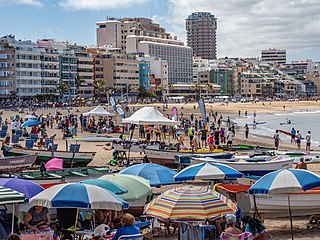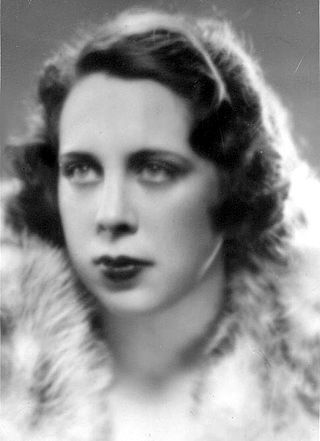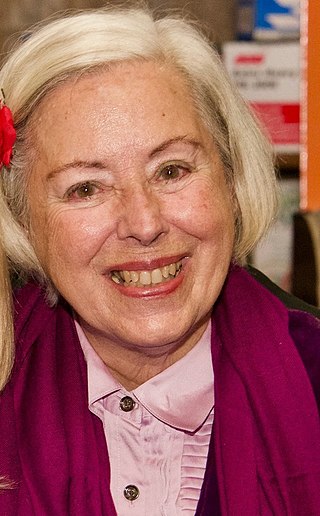
The Canary Islands, also known informally as the Canaries, are a Spanish autonomous community and archipelago in Macaronesia in the Atlantic Ocean. At their closest point to the African mainland, they are 100 kilometres west of Morocco and the Western Sahara. They are the southernmost of the autonomous communities of Spain. The islands have a population of 2.2 million people and are the most populous special territory of the European Union.

Las Palmas, officially Las Palmas de Gran Canaria, is a Spanish city and capital of Gran Canaria, in the Canary Islands, in the Atlantic Ocean.

Gran Canaria, also Grand Canary Island, is the third-largest and second-most-populous island of the Canary Islands, an archipelago off the Atlantic coast of Northwest Africa and is part of Spain. As of 2019 the island had a population of 851,231 that constitutes approximately 40% of the population of the archipelago. Las Palmas de Gran Canaria, the capital of the island, is the biggest city of the Canary Islands and the ninth of Spain.
Binter Canarias S.A. is the flag carrier of the Spanish autonomous community of the Canary Islands, based on the grounds of Gran Canaria Airport in Telde, Gran Canaria and Tenerife North Airport, San Cristóbal de La Laguna, Spain. It is a regional air carrier operating inter-island services within the Canary Islands, and other Atlantic islands, it also operates to the Spanish Mainland and some European destinations, mainly in France and Italy. Affiliated airlines operate on behalf of Binter in services to Morocco, Mainland-Spain, Portugal and Western Sahara.
Telde is a town and a municipality in the eastern part of the island of Gran Canaria, Canary Islands, overseas (Atlantic) insular Spain.

Valsequillo de Gran Canaria is a town and a municipality in the eastern part of the island of Gran Canaria in the Province of Las Palmas in the Canary Islands. Its population is 9,170 (2013), and the area is 39.15 km².

Ingenio is a town and a Spanish municipality in the eastern part of the island of Gran Canaria in the Province of Las Palmas in the Canary Islands. Its population is 29,978 (2013), and the area is 38.15 km2 (14.73 sq mi).

Canarian nationalism is a political movement that encourages the national consciousness of the Canarian people. The term includes several ideological trends, ranging from a demand for further autonomy within Spain to the right to self-determination.

Jerónimo Saavedra Acevedo was a Spanish politician and academic. He served as President of the Canary Islands twice, from 1983 to 1987, and again from 1991 to 1993.
Pintaderas are a form of stamp used by the pre-Hispanic natives of the Canary Islands. They were commonly made of fired clay. However, a number of wooden pintaderas have also been found. Most pintaderas come from archaeological sites in Gran Canaria, although natives from other islands in the Canarian archipelago used them too. Pintaderas were usually decorated with ornate geometric shapes, including zigzags, triangles, rectangles, squares and circles. These decorative motifs are similar to those found on pre-Hispanic Canarian pottery. Similar geometric patterns can also be seen in pre-Hispanic Canarian rock art

The Hospital Universitario Insular de Gran Canaria is a teaching hospital of general scope in Gran Canaria. Located in the city of Las Palmas de Gran Canaria, it was founded 13 February 1971 and consists in Februar 2021 of 503 beds. The first patient was hospitalized 20 September 1971.

The Painted cave is an archaeological museum and park in the town of Galdar, located the northwest of Grand Canary in the Canary Islands, Spain. This centre is part of the Spanish Ministry of Culture, Historic Heritage and Museums of the town council of Grand Canary.
The following is a timeline of the history of the city of Las Palmas, Canary Islands, Spain.

Dolores de la Torre Champsaur, better known as Lola de la Torre, was a Canarian musician and pioneer of musicology in the Canary Islands.
As in the rest of Spain, the majority religion in the Canary Islands is the Catholic Church. The Catholic religion has been the majority since the Conquest of the Canary Islands in the fifteenth century. This religion would largely replace the Canarian aboriginal religion through the prohibition of the latter and syncretism. According to a survey conducted in 2019, Canary Islands is the fifth autonomous community in Spain with the highest percentage of people who declare themselves to be Catholics after the Region of Murcia, Extremadura, Galicia, Aragon, and Castile and León. 76.7% of the population is Catholic.

Tren de Gran Canaria is a proposed railway on the island of Gran Canaria in the Canary Islands. It is planned to run from the island's capital, Las Palmas along the eastern coast of the island, serving Gran Canaria Airport and terminating in Maspalomas. First announced in 2004, construction on the line has not yet commenced due to funding difficulties.

El Museo Canario is an archeological museum in Las Palmas, the capital city of Gran Canaria in the Canary Islands. It is dedicated to the pre-colonial history of the Canary Islands.

The Elder Museum of Science and Technology is a museum in Las Palmas, the capital city of Gran Canaria in the Canary Islands.

María del Carmen Reina Jiménez is a Spanish essayist, writer, activist, and politician.













